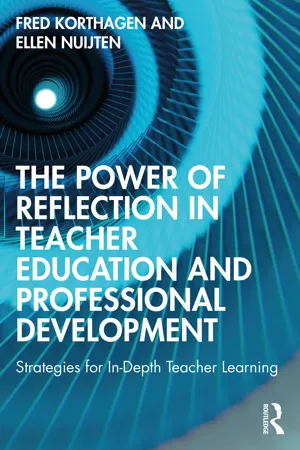
The Power of Reflection in Teacher Education and Professional Development
Strategies for In-Depth Teacher Learning
Fred Korthagen, Ellen Nuijten
- 198 pages
- English
- ePUB (mobile friendly)
- Available on iOS & Android
The Power of Reflection in Teacher Education and Professional Development
Strategies for In-Depth Teacher Learning
Fred Korthagen, Ellen Nuijten
About This Book
Based on years of extensive research on teacher development, this book offers a practical introduction to the concept of teacher reflection, demonstrating how student teachers can engage with reflective learning from their teaching and classroom experiences in a systematic and inspiring way.
Providing practical models and guidelines for use in the classroom, renowned teacher educators Fred Korthagen and Ellen Nuijten outline various strategies for promoting reflection and illustrate how a deeper form of reflection ? 'core reflection' ? enhances awareness of professional identity and supports the dismantling of inner obstacles, therefore enhancing social justice and empowering diverse student populations. The authors demonstrate how a trajectory for learning can be designed to develop key competencies, as well as the role played by university- and school-based teacher educators in supporting teachers' self-directed reflection.
Featuring a variety of tools that support professional growth, this unique text demystifies the area of teacher reflection, helping to provide concrete and inspiring examples for how to strengthen professional identity based on everyday challenges faced by practitioners. The Power of Reflection in Teacher Education and Professional Development is therefore an essential guide for students, in-service teachers, and teacher educators alike, as well as for anyone in the helping professions.
Frequently asked questions
Information
1 Introduction
1.1 The theme of reflection
The ability to reflect
Reflection by Sharon

- What do you think of Sharon’s reflection? Do you agree with her conclusion?
- If you wanted to encourage her to deepen her reflection, what question or questions would you ask her?
1.2 Not every form of reflection is equally effective

1.3 A more thorough reflection
1.4 Five steps
Patterns in reflection

- Which of the steps of the reflection model shown in Figure 1.3 usually get much attention in your reflections and which ones get less attention?
- Take a look at one of your written reflections, for example a lesson report. If you do not have one, take a situation in which you were in interaction with others, and write down your reflection on this situation.Use the margin to mark (with numbers) the reflection steps t...
Table of contents
- Cover
- Half Title
- Title
- Copyright
- Contents
- List of diagrams and figures
- List of structures
- List of examples
- List of exercises
- About the authors
- Preface
- 1 Introduction: an exploration of the concept of reflection
- 2 Working with the reflection model
- 3 Supporting reflection through coaching
- 4 Reflection in peer groups
- 5 Core reflection
- 6 Structures and instruments for promoting reflection
- 7 The promotion of reflection in teacher education
- Index